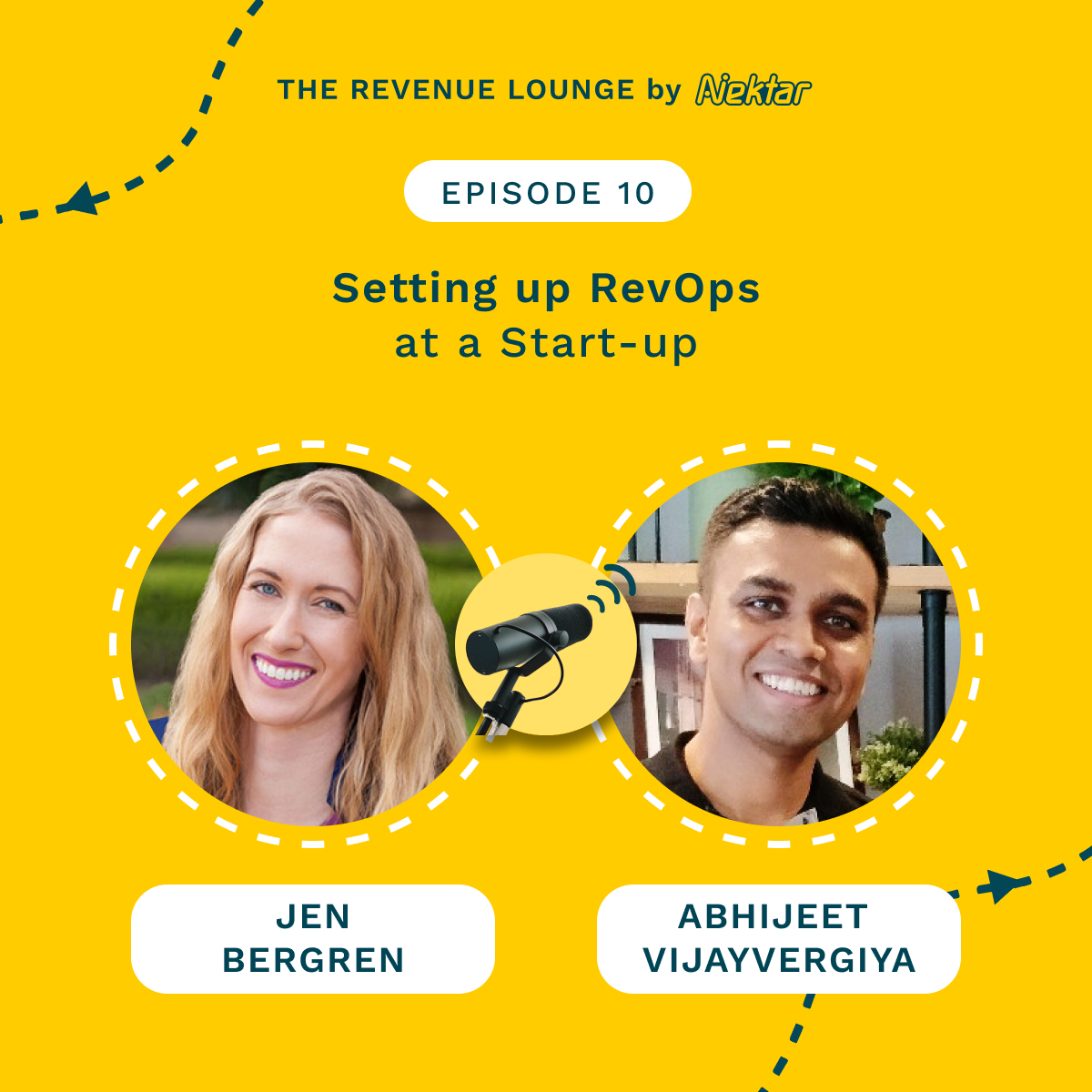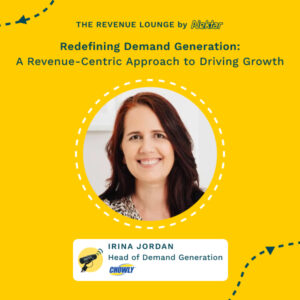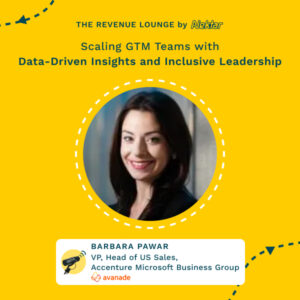Scaling RevOps in High-Growth SaaS: Key Strategies for Success ft. Josh Pudnos
September 18, 2024
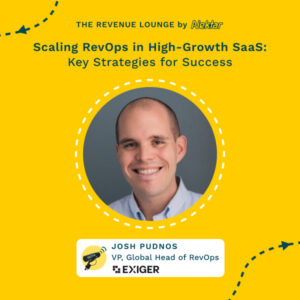
About
The Revenue Lounge
The podcast covers stories from leaders across RevOps, Sales, Customer Success, GTM, Data and Marketing about what drives these functions and what advice they would share with our listeners. With 3 seasons recorded, the podcast currently features 50+ enterprise leaders in the B2B SaaS domain. Tune in to hear from the best in the business
This episode of the Revenue Lounge features a discussion with Josh Pudnos, the VP and Global Head of Revenue Operations at Exiger. Josh talks about his career path from public policy into tech and revenue operations. He provides insights into helping companies scale their go-to-market strategies, including building out the tech stack, processes, and data to support growth. Key topics covered include:
– Transitioning organizations from services models to SaaS
– Aligning different functions and leaders around common data and processes
– Adopting an opportunity-based approach to pipeline generation
– The importance of understanding psychology and motivations in implementing change
Guest Bios:
Josh Pudnos – VP and Global Head of Revenue Operations at Exeter. Previously held roles in professional services, customer success, and operations at startups and scaleups. Focused on data, process, and scaling high-growth revenue organizations.
Exiger – Provides supply chain risk management software and solutions to large enterprises. Recently transformed from an advisory services firm into a SaaS company. Operating profitably with sights set on scaling through new market opportunities.
Key Quotes:
“Revenue operations…has a unique set of challenges. And so that was a scaling challenge of its own.” (00:02:38)
“I think human to human contact can’t be beat. I have a lot of scaling principles around just communication.” (00:12:12)
“Understanding the psychology and how people are thinking about this is so critically important.” (00:34:08)
Randy Likas (00:01.23)
Hello everyone, welcome to another episode of The Revenue Lounge. I am your host, Randy Likas. And joining me today is Josh Pudnos. Josh is the VP and Global Head of Revenue Operations at Exiger. Josh, thank you so much for joining us today.
Josh Pudnos (00:16.312)
Yeah, thanks for having me.
Randy Likas (00:17.41)
Yeah. So Josh, you’ve got a really interesting background. You’ve been in rev ops for a number of years, but you actually didn’t start your career in rev ops. So I would love to hear a little bit about your background. What got you into rev ops? Talk to us maybe a little bit about your role in the past few companies. And then we’d love to hear more about your current focus at Exiger and what you’re up to.
Josh Pudnos (00:40.313)
Yeah, sure. So actually started out in public policy in Washington, DC. So I was working for a few different organizations, lobbying around state capitals, and then kind of made the transition into tech by one of my vendors, company called Fiscal Note, and they were a startup at the time providing data and analytics to lobbying shops and government affairs departments.
From there, I got my feet in various different go -to -market roles, professional services, customer success, implementation, moved to New York eventually with different organization, implementation, CS, strategic operations, and that sort of made my segue into revenue operations. Looking at data and how do we maximize, or how do we go to market using different data points and thinking strategically about.
our resources and all those different things. So it was a strange transition, but this is really actually where my home is I think now.
Randy Likas (01:46.894)
Yeah. So one of the things that I think is interesting is when you joined Brandwatch, you took the company at a time when they were about $100 million up to $200 million. And certainly, think at Exegger, you guys are in growth mode, growing profitably. But the company was doing it previously to you joining, they were going through a little bit of a transition, right? And so maybe they, for professional services, I think, over to more of a SaaS business.
So you’ve got a lot of experience, like I think, helping companies scale their go -to -market. And I would love to hear a little bit more about when you think about scaling a revenue operations organization, where do you kind of start? And what are some of the key challenges, I guess, taking a company that maybe has some immature processes to getting them ready for growth?
Josh Pudnos (02:36.333)
Yeah, so going back to my time at Brandwatch, it was actually more of a story of transformation and scaling. When I joined, it was actually a company called Falcon .io. it was actually, it was a very well run organization and ended up being married with another company called Brandwatch, basically merging two organizations of equal size together. And so, you know, that was a scale journey of its own. And the transformation there though was,
It’s a sizable, really challenging and long process to anyone who’s been through acquisitions and mergers go through their various challenges and how do you integrate the organization from a cultural standpoint, all these other things. On the revenue operation side, not only do you have to incorporate different technology, different
different policies and different things. In a lot of ways, you now also have to incorporate different methodologies, psychologies, philosophies, learning how different leaders think and how they want to work, and then integrating all that together. So it’s like an extra added layer, think. Hopefully not unfairly, I think this is actually a harder thing, more challenging endeavor for revenue operations than maybe any other.
function in an organization or at least has a unique set of challenges. And so that was a scaling challenge of its own at Exager where I’m at today. We’re going through a different transition where it’s transformed. It’s been transforming before I joined from more of an advisory firm into an enterprise SaaS company. And so when I joined, almost going on two years ago,
really at the beginning stages of that. And so I think this is more, it’s, even though we’re now an 11 year old company, you know, as a SaaS company, we are still sort of in those earlier stages and working on the scale there. And so, you know, the challenges there is like, you know, one unique set of challenges has been working with the leadership organization to transition a lot of frameworks and methodologies from
Josh Pudnos (05:02.117)
a really different type of doing business into more of a, you know, SaaS best practices that, a lot of times the metrics are different and things that matter, things and how to scale those, just a different frame of mind. you know, that’s been a unique challenge getting folks on the same page. They’re coming at this from different levels of not maturity, but different levels of
familiarness with the challenges that face a SaaS organization.
Randy Likas (05:37.119)
So specifically, some of those challenges, is it the change management that’s the issue? Is it the nature of the functions kind of operated independently, siloed, had their own metrics that didn’t necessarily align? Maybe if you could talk a little bit more specifically about the challenges that you faced and how you go about solving those.
Josh Pudnos (05:59.555)
Yeah, so Exeter specifically was structured in a way that is more fitting of an advisory firm. so siloed different business units that I think at a SaaS, had the company started just a couple of years ago as a SaaS company from scratch, probably would have been combined organizations.
There were a lot of different approaches to go to market, a lot of different sales motions, lot of different structures, like multiple different structures to teams. as a newer sort of organically grown SaaS company, just see you have an AE organization selling new business, you have account management, renewing and upselling and cross -selling, have customer success, working on that adoption.
Josh Pudnos (07:00.451)
when I joined just two years ago, we had just made that transition and not even consistently across the organization. And so we were just learning like, what does an account manager do? What does it mean to renew and upsell and cross sell? How do you prioritize your accounts? What signals can you use? What data do you have at your disposal? And so that was very new at the time.
working with leaders and thinking through some of the mechanisms we can use to identify opportunities and build pipeline. And now we’re a little more into it. And it has its challenges at this stage as well. still, now we’re operating off of, you have some people who I think you have difference of opinions starting to really develop and this is working for me for these reasons.
Whereas, you know, another business unit or somebody in a similar position might be struggling with certain endeavors and it’s less clear why. Well, we a different segment. We’re talking to different customers. And so it’s still hard to, you that’s when you like to get the data involved. Like, what does the data say? But I think a unique challenge to revenue operations that we’re, you know, acutely aware of.
all the time is the integrity of the data, not just like from garbage in garbage out perspective, but understanding the nuance of what the data is telling us and what it means, the fidelity of that data. What does it really mean? What are the hidden bodies within that data? And how much can you really drive your strategies from that given what you know about it? And how do you communicate that with your leadership in a way that
Randy Likas (08:35.459)
Hmm.
Josh Pudnos (08:55.108)
which helps move the business forward.
Randy Likas (08:56.802)
Yeah, so let’s dig in on the data piece for a second because in preparing for this conversation, I was doing a little bit of research and I think I heard you say at one point, like when you first started, like you had a Salesforce instance, you know, but there was nothing really behind that. It wasn’t a great tech stack. And so, you know, what did the data look like when you first started and how do you actually move the organization both from a…
philosophical approach where like this is really important. We have to use data to guide our decisions and then like what specifically do you kind of put in place to help make sure you gather all that data?
Josh Pudnos (09:34.019)
Yeah. So first of all, the data was inconsistent. It was being input by some people at different rates than their peers. And so from person to person, it was different. And because there were really no rules or guidance or guidelines around what needed to be input and when and how and what it meant, it would also differ from opportunity to opportunity. And so
Basically everything within Salesforce when I joined was, you know, couldn’t be trusted. And we felt like we needed to essentially start from scratch. you know, any data prior to 2022 is completely, you know, there’s a amount of salt that we take with any data point within that. You know, we still have some decent lead data. But beyond that, you know, any pipeline information is really, really suspect. So.
Once we did that, started reviewing the processes. What is the process from a lead to a contact, contact to an opportunity, account creation, the sales stages, and trying to standardize those in a way that was consistent across the organization, regardless of the business unit. We started building a more standardization, a lot more requirements that had to be filled out.
I’m doing a lot of education around what different fields meant. What fields are required for a new business opportunity versus renewal versus growth. We’re also still transitioning from a business from very services oriented products, which behave differently, which we wanted to classify differently in Salesforce than the direction
that we were moving, which is very ARR focused and recurring products. And so there were a lot of moving pieces all at the same time. So as we were literally rebuilding the flows and processes within Salesforce, educating folks about the new processes, we were also starting to add in different layers of additional parts of the tech stack. So we added a sales
Josh Pudnos (12:01.687)
engagement tool to really enable much more of an outbound motion, which was new to the organization as well. I just built out a team of BDRs doing inbound and outbound, brought on an instance of CPQ to start structuring that process and getting people… I think a big part was getting more confidence in the…
confidence and granularity in the data that was going into like what products are being sold, how much is this ARR or is this non -recurring services? And so over time, over the last year, we start seeing more and more confidence in the pipeline data. And let me be very clear, by the end of last year, and we actually had
a really great exit to a private equity company or a few different new owners, which this was a major part of. Like we now had, you know, through the due diligence process, we were highly involved in running analysis. We now could, with a decent level of confidence, be able to provide information about the pipeline to help underwrite the deal, to help understand what our customers look like, have decent integrity around.
the a lot of different data points, industry, size of organization, products being sold.
Randy Likas (13:29.697)
Mm
Josh Pudnos (13:35.374)
ton of just so much room for growth constantly, even in that now we’re coming up on almost a year since that process began. Long way to go, but I think over time, just seeing more more integrity in that data so we can trust it and forecast a lot better, understand what was happening in the business. And so that’s sort of been our journey. There’s still a long way to go and a lot more we can do to better understand what’s actually going into and coming out of our business.
Randy Likas (14:05.56)
So let me play that back, because you said a lot of really good things there. you started, you had a Salesforce instance, not a whole lot of process behind that, probably not the best, I’m hypothesizing, you probably have the best adherence to making sure that we’re holding reps accountable for making sure we’ve got good data in the system. So there’s a bit of a, an operational challenge to just get the rep behavior changed. But then you’ve got different functions, right? You’ve got sales leadership, you’ve got marketing, you’ve got customer success.
that probably looked at what they had or how they approached data a different way, and you had to sort of get them all aligned with that. So like, can you give us an example of maybe a specific process or a specific area where you had those operational struggles, right? And how did you overcome those and ultimately get sort of people on board?
Josh Pudnos (14:57.817)
Yeah. I think we’re still trying to figure that out in a lot of ways. We’re constantly iterating on it.
Randy Likas (15:02.05)
Yeah. Yeah.
Josh Pudnos (15:08.195)
I think human to human contact can’t be beat. I have a lot of scaling principles around just communication and I write a newsletter. It’s not as frequent as it used to be, but I think it’s probably for the best. I try to do it a few times a quarter to help people understand what it is we’re building and what we’re driving to and how that relates to the KPIs.
Randy Likas (15:20.812)
you
Josh Pudnos (15:36.355)
You know, I meet very regularly with my sales leadership team individually and together. I think certainly by now we’ve coalesced around like what are like, we’re very clear about it. We’re driving towards ARR. Our, you know, our services revenue is incredibly important, but it’s just, it’s really a different stream and a different focus. And so we’re prioritizing that in a different way. You know, we’ve gone through even in the, you know,
Randy Likas (15:56.098)
Mm -hmm. Mm -hmm.
Josh Pudnos (16:03.588)
about a year and a half, we’ve gone through multiple iterations with my marketing team in understanding and classifying what an MQL is, what an SQL is, like what are the metrics, how are we measuring those, adding in layers of lead scoring and…
intent data and how we understand and think about that and how we measure that as, know, as how we use those to understand what’s happening with our business, the quality of what’s coming in, what’s converting. So we worked on standardizing those and have iterated. And I think that’s really critical because, you know, we’ve learned a whole lot about business and what’s working, what’s not, and what we don’t understand, we have a better grasp on.
So that’s going to be a constant iteration. think that that’s a truism for our business, whether we’re a few years into maturation as an enterprise SaaS company or we’re a decade into it. think we’re constantly going be learning, we’re going be adding in new challenges, new missions, new objectives. so just understanding that constantly coming together, calibrating off of each other, but being willing to change, understanding that change is necessary.
I think we’ve all aligned over time on that fact.
Randy Likas (17:20.822)
And it probably makes it easier when you get these little small wins where people start seeing the progress, right? And we start seeing kind of why we’re doing that. I guess I have more of a higher level question. So the business was probably doing pretty well before you started making this transformation, right? I think I saw that COVID enabled you guys to really kind of expand the different opportunities and market opportunities for you. So.
The business was doing well. Why make the transformation? So like when executive leadership decided to do this, was it because of the benefits of recurring revenue or like what sort of led to what seemed to be pretty successful to making that change?
Josh Pudnos (18:00.931)
Yeah, so the evolution of this company is actually really fascinating. It started as sort of a regulatory mandated executorship over a bank to ensure that they were conducting the right due diligence process. And so the services that Exeter was providing early on were oriented towards knowing your customer and stuff like that.
really kind of basic blocking and tackling as part of financial institution processes. Over time, it built some tech to enable that, to do that much faster, to do it better, more efficiently, started acquiring some tech. And then we started getting to the space where we’re realizing here, hey, there’s a real need for organizations, not just banks, but organizations to understand at a really deep level that they can trust the…
the vendors that they’re taking on this third party risk management space. So we started kind of evolving into that space. Again, build tech, buy tech, and we’re starting to see signals now, hey, there’s a really great application for this at the supply chain risk management level. Enter COVID, is, know, like supply chain risk was something that we heard about on a daily basis, even, know, whether you’re, you know, whether you’re working at a manufacturing
you know, whether you’re an executive at a manufacturing company or you’re, you know, a teacher in middle America, like you knew that supply chain during COVID was a major, major global issue. And so, and I think that’s where we saw a lot of signals. we still continue to build and buy tech, incorporating it. that’s, know, Enter 21, 22, while we still had a great business working for financial institutions, providing
due diligence risk mitigation and helping them with compliance, there’s a huge signal and incredible customer fit for the supply chain risk management use case. And there’s so many different sort of vectors into that, whether it’s regulatory compliance and we’re seeing different regulations come out around the world, different jurisdictions around carbon emission, regulatory reporting.
Josh Pudnos (20:25.629)
for your supply chains were seeing it around regulations around so that you know modern slave slave labor regulations and ensuring that you don’t have you know improper
practices in, know, whether it’s your direct suppliers or deep, down in your supply chain, so many different ways in that we serve a really enormous part of the economy and it’s continued to hit. So we saw the signals and we said, hey, we need to mature. We need to develop an organization that can properly go to market and serve customers with this need.
And so that’s really where the investment came in and decided to really build out this organization.
Randy Likas (21:14.658)
Yeah, that’s really interesting. So you talked about the market signals, right? There’s different regulations that are coming in, making changes, and that’s kind where you see the opportunities. Then you look at, like, OK, who are the companies that we can go after to help sort of solve this? And I’m going tie this back to working with your marketing team in terms of defining MQL, SQL lead scoring, that type of thing.
A lot of SaaS companies right now, past 12 months, been finding it extremely difficult to develop pipeline, right? MQL costs are going up, quality is going down. More people are involved in the buying decision than in the past. Approvals need to go higher. All those things. And so people have been thinking about maybe MQL is not the right metric for a business. Maybe we should start thinking about more of the buying group and the buying committee and identifying those stakeholders who are maybe
giving us signals that they might be in market. I don’t know if you know, if that rings true at your organization or not, but a lot of companies are starting to think about like, how do we organize more around opportunity -based marketing as opposed to MQL? Is that something that you guys are all considering or are you guys a little bit unique in that situation?
Josh Pudnos (22:28.109)
No, it’s definitely, it’s something that has been a big part of our journey, especially this year, where we’re learning lot about intent and have brought it into our tech stack and our process, but we have a long way to come in terms of maturing that and really making it part of our process. very much so, mean, we know, we’re selling to some of the biggest organizations in the world. And generally speaking, this is not unique to us. We’ve heard this from
around the market that the buying committee, I don’t know the exact number, you hear different numbers, but it’s in the realm of like 10 to 20. There’s a lot of people that are directly or even tangentially involved in the buying process, as well as other people, adjacent stakeholders who can come in and we can help influence the process. so not only do need to have a strategy and not organizations like us need to have a strategy for how do we
build relationships with all of those folks, but how can we continue to influence them through marketing or other means? Critically important, definitely and utterly we need to continue and invest and understand and build out, not just from a marketing standpoint, but a sales approach. Something I would love for our sales reps to do a whole lot more of is, I don’t even think it’s fair anymore to just call it like multi -threading. is something even much more mature and complex than just that because
And you you engage with each different person of that, let’s just call it a 15 person buying committee. You know, they’re, going to each, each of them are going to have different communication styles and modes. know, some are going be on the text basis. Some are on a phone call basis. Some of them will only be there on a zoom call, you know, with their, with their video off. Like you have to think about them and engage with them in a different way and understand what they care about and what their roles in the buying process.
Randy Likas (24:26.946)
Yeah, you’re absolutely bang on. And I think the other thing is, a lot of people are thinking about buying committees and buying signals. They tend to think about it at top of funnel, meaning like people who are showing intent or showing signals. But there’s so many signals that exist from your existing data, from previous buying cycles maybe and people that were involved, that is locked up.
inside those communication systems because reps are not good at updating that. They’ve got it in their head or they’re multi -threading kind of on our account plan, but they’re not entering the data because quite frankly, it’s an admin work for them. They got more strategic things to do. But a lot of people are starting to look at how do we take more advantage of the existing data in previous opportunities and pull that out for the future. So it’s just a really fascinating time to be in marketing and sales and the changing dynamics of like…
being MQL focused over the spine group motion. So it’s really just gonna hear your perspective on that.
Josh Pudnos (25:26.861)
Yeah, absolutely. know, this is actually, you know, I said it’s sort of newer to our motion this year. We’ve actually already had a few cool instances where we said, you know, these, this cohort of deals are not progressing the way that we want or maybe even need them to. What can we do from different angles to help advance this? Certainly, you know, we can get different leadership involved and bring, you know, have them get introductions through board members and stuff like that. Kind of the more traditional.
Randy Likas (25:43.49)
Mm
Josh Pudnos (25:55.896)
perspective, but we started saying, Hey, we now have this marketing intent signals, like, how can we leverage that to help advance it? And I don’t think we’re sophisticated enough yet in terms of saying, Hey, this is a, you know, this deal is at this stage and we need these triggers to happen. And so we’re going to, we’re going to engage them in this way. But I think the, V one of that has been, we’ve just called it like surround them. How can we surround them with, information about our company, about
you know, use cases that are similar about, you know, case studies and other ways of just getting our solution into just awareness. mean, think that’s just, that would be a great win if every single one of those people walked away, know, like hopped on LinkedIn and saw our name and they said, yeah, we are, we’re engaging with that, with that organization. I hopped off that demo. That was actually pretty cool. Like I want to learn more about that.
I’m going to go to the website. I’m going to learn more. Like that’s a win. And that’s, you know, those, those little steps are going to help us to deal. I think, think and hope that we, we only get more successful and get more at bats at doing stuff like that, because I think it’s, it’s really exciting. So we’re starting to measure that a bit. We’re going to learn from it. And definitely, I think it’s, it’s worth investing to do a whole lot more.
Randy Likas (27:16.108)
Yeah, yeah. So let’s get back. So I would love to understand a little bit more about, as you think about setting the correct foundation to scale the business, how do you organize your team? So do you organize them around certain functions, like we’ve got a marketing app, sales ops, customer success ops. Do we have specialists or generalists? So we’d love to hear kind of like when you think about just the structure of your team.
Josh Pudnos (27:41.912)
Yeah, so right now I still have a fairly small team. I have two folks on my, we call it revenue operations systems. all the systems that, know, obviously for us, Salesforce is sort of the central spoke of all that, but everything plugs into that. So they’re more technically oriented. I have a head of sales ops and one person under him. And that’s, you know, that’s really everything from, it’s really like more of the strategic side from.
know, top of the funnel through client success that we’re starting to think about. And then I also have one person with sales enablement and I sort of, you know, I’m very much a hands -on person and evolved with all that. it’s, you know, it’s it’s a mighty group, a small group. And, but as I, as we build that out, I think it’s really important to be sort of stakeholder oriented. you know, yes, we are probably, we’ll, we’ll be oriented in developing more specialization.
based on parts of the funnel. But I think it’s really important to members of my team who are more out in the field, maybe not so much on the technical side, but be oriented and aligned with specific leaders in the organization. And they happen to be usually pretty focused on either BDR, STR, or AEs and AMs, CSMs. But I think it’s important that
those leaders have a business partner within revenue operations that they can go to to ask questions that, you know, building strategies, running reports, understanding, know, getting insights from those, you know, seeking advice on these things. So that’s typically how I like to orient things. As we get bigger, we may have, you know, cross -functional specialists doing things from commission to, you know,
planning and other things, we’ll have to see how the business develops and changes.
Randy Likas (29:45.918)
Yeah. One of things you’d mentioned is like we’ve got the people who are working with us with their business. one thing we often hear is like the challenge of balancing the ad hoc requests that we always get. Hey, can you run this report? Can we look at this? And it’s like, we’ve got the data in the dashboard, but people don’t look at that type of thing. And so there’s this struggle of, I’m getting all these ad hoc requests, yet I have to work on more of the strategic projects to advance some of our key goals.
How do you go about managing that in your team?
Josh Pudnos (30:19.865)
Yeah, I don’t think there’s a revops org out there that doesn’t face this and something we’re always trying to get better about. would say, one thing that we try to do a lot of, and we have quarterly initiatives that, and sometimes they span multiple quarters, we’re still building out a lot.
Randy Likas (30:24.174)
Great. Yeah.
Josh Pudnos (30:41.944)
We do our best to communicate that just like really thoroughly, help everyone across, you know, from the rep level up to leadership, understand what those objectives are and why we’re doing it, it ties back to. And we’re constantly pushing that message. It’s very thematic. We’re building out this capability so we can do this. You know, today we have this problem, you know, we’re addressing it by doing this, this and this. And so I always try to tie back what we’re doing.
to those mission oriented, those larger objectives, so that when we get a request for an ad hoc thing, we can more credibly say, okay, explain to me why you need me to do that. Pointing them into the right direction to hear, this is actually already on this dashboard. That’s one thing. I think repetition is really important in our communication with stakeholders. But I wanna empower my team.
Randy Likas (31:30.04)
Yep. Yep.
Josh Pudnos (31:40.004)
to say no or to say, hey, that doesn’t really make sense right now. Or you can achieve that, you know, by doing these, you know, this is, this is, this is 90 % baked. You just have to tweak it this way and, know, kind of self -service a bit. But we have to be able to, we have to be empowered to say no. We have to be empowered to say why, what’s driving that? Can we delay that? actually, you know, we’re, you know, next quarter, you know, this is sort of on our roadmap to do this.
and we’re going to be better positioned to do it more thoroughly and comprehensively next quarter. So, yeah, ultimately we want, just like sellers, we need to ask why and understand what is the pain point and how painful is it, what’s driving that and all of those things.
Randy Likas (32:24.812)
Yeah. Just out of curiosity, does revenue operations report up through sales, operations, finance there?
Josh Pudnos (32:34.927)
So we report into the CFO and I know this is always a big topic. People have pretty strong opinions on it. think ultimately it comes down, CRO or CFO is usually the question. I’ve had great success. think I have enjoyed it both ways. think it ultimately comes down to the person. And we have a great CFO here who is…
Randy Likas (32:36.622)
See you.
Josh Pudnos (33:03.818)
a SaaS veteran understands what we’re trying to achieve. Whereas we don’t have a centralized CRO function, we have multiple sales leaders that are a little more of like a confederacy in a sense. It makes more sense to be more centrally focused here. I think people talk about like a helpful dissonance between rev ops and sales. I think that’s why I think there’s a lot of
validity and having it report to the CFO. And certainly one thing you don’t want to happen is like you don’t want revenue operations to turn into a propaganda arm of sales, which I’ve seen in some sense. you know, having sales aligned with your financial goals and being able to push back on both parties or either party or any of the other stakeholders. mean, we interact a lot with
know, and marketing and so many different functions that you need to be in a position to partner with folks as well as push back and be a good business partner.
Randy Likas (34:11.992)
Yeah. What do you think the, I guess, reporting through a CFO, and maybe they’re the same, but if you think about how revenue operations as a function is measured, right, the KPIs that you’re measured against, what are those, and are they similar to the other cross -functional stakeholders? Is it based on, I guess my question is, is it based on revenue, or is it based on other types of things that you’re measured on?
Josh Pudnos (34:40.236)
Yeah, definitely, definitely I’m moving goal line, but ultimately, I think we are, we are measured, at least at this organization, a bit like sales leaders. What is the revenue that we’re bringing in? Because, and I think that’s the right way of thinking about it too, because we should be building an efficiency. We should be building in, you know, we should be able to
highlight opportunities for new strategic initiatives that are going to be bringing new doors. We should be able to point out where things are getting stuck and unstick them. so I do think ultimately our attainment to our top line sales target is really important. And I think also one thing that I haven’t
seen be as important and at other organizations where Red Ops is aligned to a sales leader is thinking about profitability as much. I’ve only really been at this organization since the transition globally to the not growth at all sales world. I’m sorry, not sales at all costs.
type of world where this is, you know, I happen to be at a company that has always been profitably oriented because it hasn’t been, you know, this venture backed startup. we have, we, yeah, we’ve, we’ve operated profitably. And so I think to also have a, a bottom line orientation is really important. Like, yes, we’re hitting our sales goals, but at what cost can we be EBITDA positive or at least neutral and how do we get there? And so.
That’s not something that sales leaders are as often thinking about. I think being within the financial organization helps you, know, increase you a bit more on that. Maybe it’s not, it’s not our, you know, our number one goal, but it’s at least in the back of our mind a lot of times.
Randy Likas (36:54.402)
Yeah. So you’re going to be there for, I guess, January is going to come up on two years. Having hindsight as the benefit here, what would you do differently to help you guys scale?
Josh Pudnos (37:09.046)
Yeah, so first of all, you know, when I came in, I was sort of blessed with a decent sized budget to and a mandate to go buy tech tools. We wanted more automation and efficiency. And I came out of the gate, you know, like a bat out of hell and acquired a bunch of And knowing also that a lot of the leadership didn’t, wasn’t familiar with
the attacker or the objectives that we’re trying to build this or even like what the team, how the teams would operate. And I did. So I was sort of empowered to just go do it. Like, know, you you know what to do. And honestly, I think what I did was, you know, I didn’t, you know, I maybe discounted
reps opinions and perspectives more than I should have under the assumption that hey they didn’t come from this world. This buying motion is brand new to them. so adoption is hard anywhere. Adoption of tack and processes is hard under the best circumstances. But I was coming into an organization where not only did they not want to do this but they didn’t understand why and not really understanding their
Randy Likas (38:17.688)
Yeah.
Josh Pudnos (38:32.866)
method of operation and how they’re motivated to comply with some of these things discounted a lot. so some of the tech that I, the vendors that I brought on were not…
just probably probably weren’t the best investments. And I definitely, you know, I have some of my two year contracts coming up in the new year and I’m not, I’m not going to renew all of them. And, know, I’m actually very excited about the prospects of that. Definitely an area that I miscalculated a bit on and wouldn’t do so much in the future. was slowed down a little bit. You know, I was highly motivated coming in to make massive change as fast as I could to help this organization hit very lofty end of year.
Randy Likas (39:14.626)
Yep.
Josh Pudnos (39:17.668)
2023 goals and could have achieved that in different ways in hindsight.
Randy Likas (39:26.028)
Is there, are there any gaps that you have, either in the data or the people or the process that you might take some of that money that you’re, you know, reinvest in other areas to fill some of those gaps? And if so, what would those be?
Josh Pudnos (39:38.916)
It’s a great question. There are gaps, I think, but I don’t know if I’m going to invest in that arena. think right now what my focus is starting to pivot towards is are there existing tools that we can leverage, especially with the explosion of AI? What can we do to make
my reps lives easier in inputting this data? How can we automate, how can we extract data points from their calls and emails and help potentially use that to keep their pipeline cleaner and more up to date?
make fewer buttons to click, that’s gonna be a huge win for next year. so, yeah, I think in that realm, there’s a lot we just need to learn more about and continue to focus in that arena rather than going out and buying new tech. We wanna see more of what we can do with the existing stack.
Randy Likas (40:47.768)
Yeah. So I’ve got one more question for you around scaling and operating before we kind of transition into what we call our lightning round. So what haven’t I asked you about that maybe I should have? Like what area that’s sort of been critical to help you scale that we haven’t covered yet that maybe you’d like to share?
Josh Pudnos (41:08.376)
your question.
Josh Pudnos (41:12.552)
you know, I think so much about revenue operations is there’s the technical, there’s the strategic, but so much about the, the, the part that’s not spoken enough about is the psychological and the philosophical. there’s so many decisions that I recall later today, with my CFO and heads of sales about this one sort of esoteric way of how are we going to log, how are we going to classify
this one edge case of renewal that’s, and we’ll get into the complication, but it’s so funny that it’s this philosophical decision about how we want to book this deal. And it’s just, it’s funny to me that we live in this world where people are, and people are passionate about it for reasons that I can’t quite explain, but I have to understand that they,
certain feelings about it and what those feelings are based on in order to develop my strategies and not just about this one issue, but I think this applies to everything from sales methodology. What’s the difference between stage X and stage Y and what goes into that? Understanding the psychology and how people are thinking about this is so critically important and also the challenge of marrying person A and person B’s psychology. How can we
how can we get to a more perfect union and be seen from the same song sheet and all other sort of cliches? How can we have one set of data and understand it in same way and be able to repeat that? That is ultimately the biggest challenge and the biggest key, I think, to revenue operations. can get, know, the technology helps you get there. The strategies come out of that if you do that part well.
And if you don’t do that well, the strategies, the analysis becomes much harder and maybe weaker.
Randy Likas (43:18.456)
Yeah, what’s really interesting about that is, I mean, that’s the same thing with any large complex cell that you’re trying to get people to make a change. You gotta understand the psychology. Why are they deeply rooted in certain opinions or wanting to maybe change or not wanting to change? So a lot of the same principles that you just spoke about are really important as you’re trying to pursue your large complex deals as well.
Okay, so let’s transition to the lightning round. Just more sort of personal based, not so much about RevOps, but more about you. So we’d love to understand, I guess the first question would be like, having years of experience now under your belt, what advice might you give your younger self who’s starting to get into RevOps operations that maybe avoid some of the challenges that you went through? What might that be?
Josh Pudnos (44:07.704)
Yeah, I’ve definitely taught myself to invest in the relationships a whole lot more. Get that face time, understand what’s driving them, ask more questions of my sales leaders to understand what their problems are. Certainly push solutions a whole lot less. And just again, just like we try to train our sellers, just ask the questions. It’s about them and the problems that we’re trying to solve for them, not, hey, this is what I can do for you.
And my younger, I might tell myself from last week that too, like not just me in my 20s or something. I think it’s relevant today and it’s a good reminder for myself.
Randy Likas (44:44.44)
Yeah, great. What’s your favorite part about being a head of rev -ups?
Josh Pudnos (44:51.14)
I think it’s seeing that organizational change in maturity and being part of that and help driving that. Again, I think probably maybe the most proud moment of my career has been, we went through this giant sale at the of the year and I kind of came to the realization that had we not made some of the changes, and I don’t know if my CEO would necessarily agree with this, but I think we were a big part in being able to
validate the value of the business because we had now data that we could trust about how our business was doing. Again, a lot of room for growth, something we could trust. That was a part of getting the deal done for sure. Making that transit could not have done that. Had that sale happened a year before, I don’t know how we would have done that with a degree of confidence. That’s huge.
Randy Likas (45:35.202)
Yeah, that’s my f
Randy Likas (45:46.2)
Yeah, that’s awesome.
Josh Pudnos (45:48.322)
It took a lot of different people changing their behaviors and the organization acting differently to be able to get there.
Randy Likas (45:53.422)
Yeah, that’s great. What is the flip side of that question? So like, what’s the least favorite or I guess ask a different way, like what’s really hard about your job?
Josh Pudnos (46:04.452)
I it comes down to the adoption. I’m always trying to be really thoughtful about what’s the right venue to roll out this new process change? How do I, it’s the end of the quarter. We really needed them to do this new thing, but they’re heads down. Or I’m never gonna get the time of day to do this. Or I’m gonna send this out over Slack and an email and they’re not gonna read it. So how do I get them to adopt this new thing? How do I get leadership buy -in to ensure that they help?
push it and enforce it and you know slap wrists of those that are not following the new process like that’s, man it’s tough and so you know that’s not so fun.
Randy Likas (46:46.178)
Yeah. What advice might you give to somebody who’s starting their career in rev ops, maybe you’ve had a year or two, but they want to accelerate their career, they want to be in your job someday. What advice would you give them?
Josh Pudnos (46:58.457)
Yeah, I actually, I really, had this conversation with a lot of folks or a lot of times it’s like, you know, folks that are sellers that are trying to transition into rev ops. You got to be able to speak, you know, talk to talk and understand, you know, there’s so many awesome resources out there, some really great, you know, podcasts, not to be too self -serving, some really great resources out there, newsletters.
At a very high level, I haven’t really seen anything that’s like, you know, for the sales ops analysts level. Everything is much more oriented towards leadership. But I think just understanding the different types of situations that you’re to come up against the different, you know, best practices. I’m constantly consuming that stuff. And I think you need to do that as well. So definitely be a professional, learn what the professionals do.
You know, what are the different scenarios that you’re going to come up against? What are the different objectives that you’re going to be asked to do? How do you approach that? Go to the conferences. There’s, you know, some really great things popping up, especially if you live in a major city. Go to those things, get around the people, you know, people are going to say build a network. Of course, definitely do that. like, learn, learn how the professionals think about this profession because it really is and can and should be.
Randy Likas (48:21.39)
Now that’s excellent advice. So listen, I know we’re coming up on time. just, Josh, I want to say thank you very much. I think this is a really great, insightful conversation. Thanks for being as candid as you were. Have a great rest of your day and weekend.
Josh Pudnos (48:33.848)
Thank you, you as well, appreciate the time. Bye.
Randy Likas (48:35.523)
Thanks.

Ep #1: Navigating the Downturn with a Hyperfocus on Productivity
Listen Now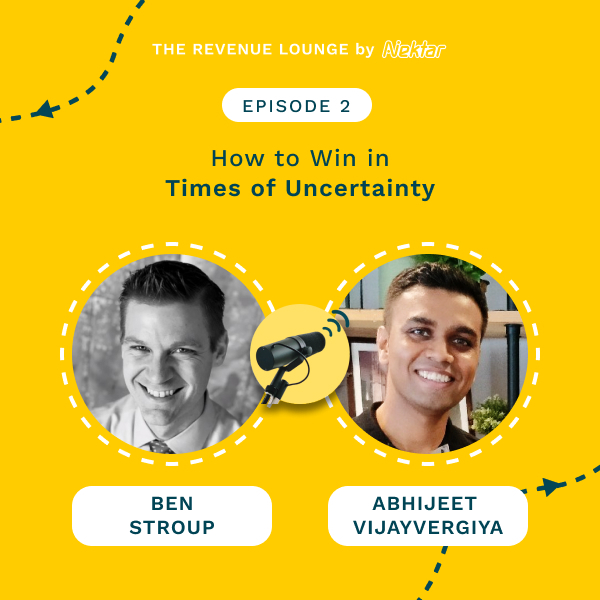
Ep #2: How to Win in Times of Uncertainty
Listen Now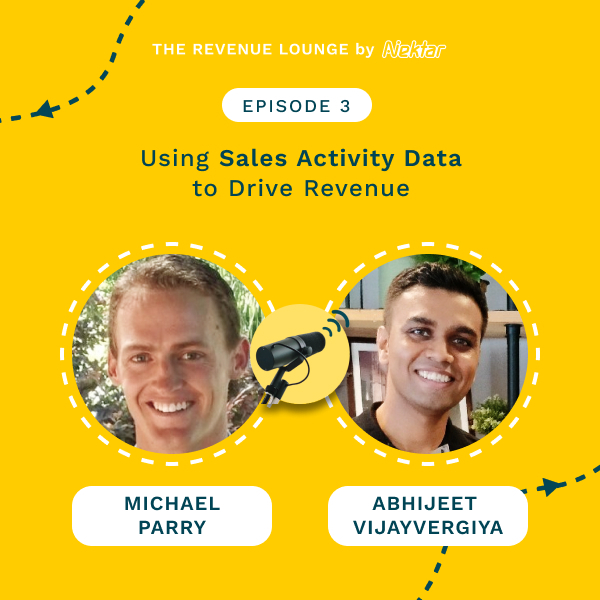
Ep #3: Using Activity Data to Drive Sales Productivity
Listen Now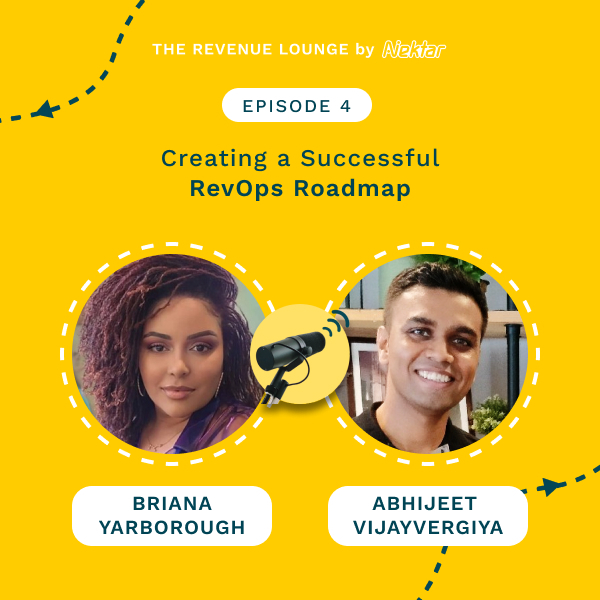
Ep #4: Creating a Successful RevOps Roadmap
Listen Now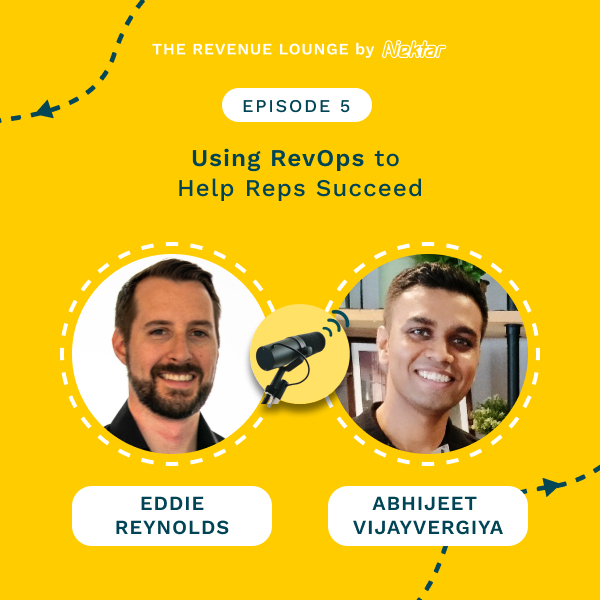
Ep #5: Using RevOps to Help Reps Succeed
Listen Now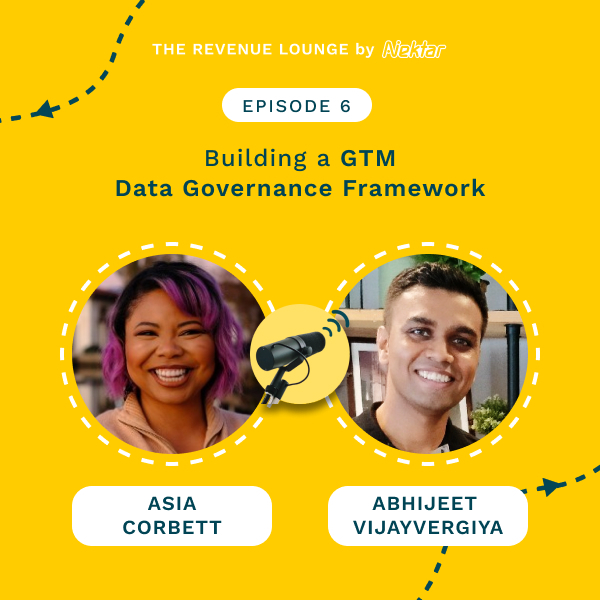
Ep #6: Building a GTM Data Governance Framework
Listen Now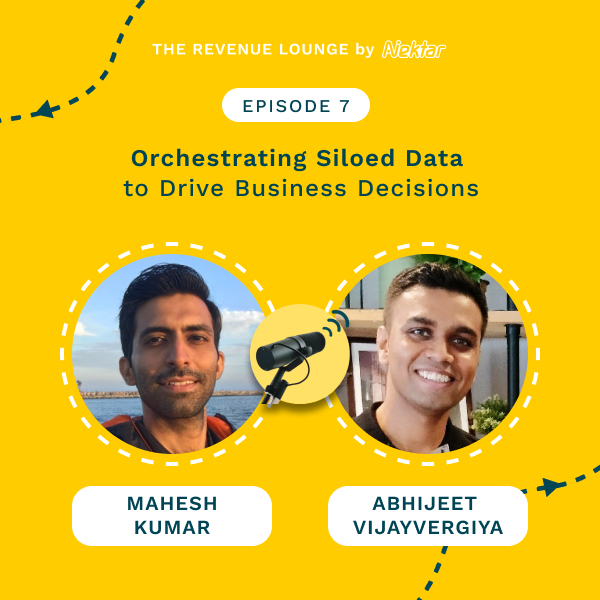
Ep #7: Orchestrating Siloed Data to Drive Business Decisions
Listen Now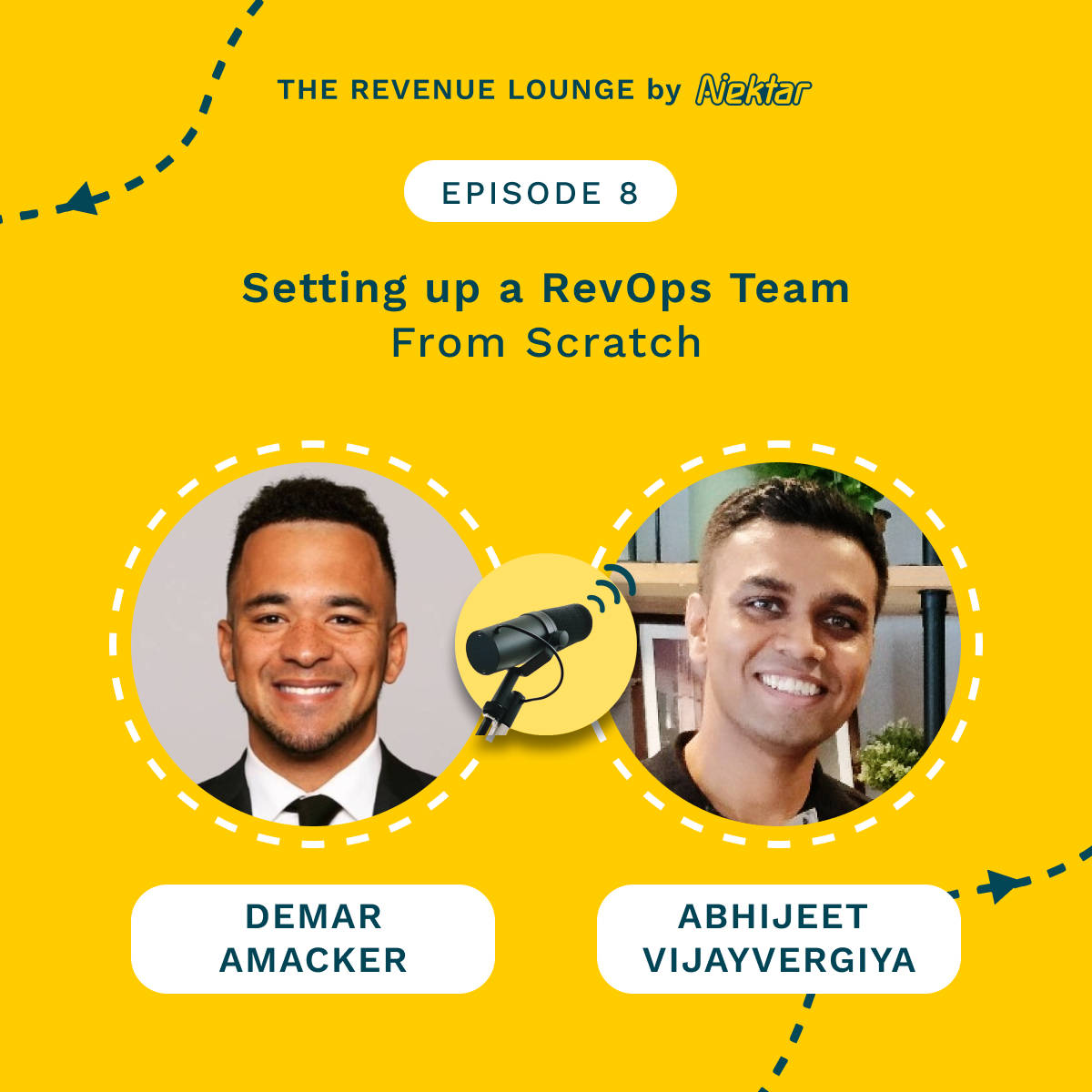
Ep #8: Setting Up a RevOps Team From Scratch
Listen Now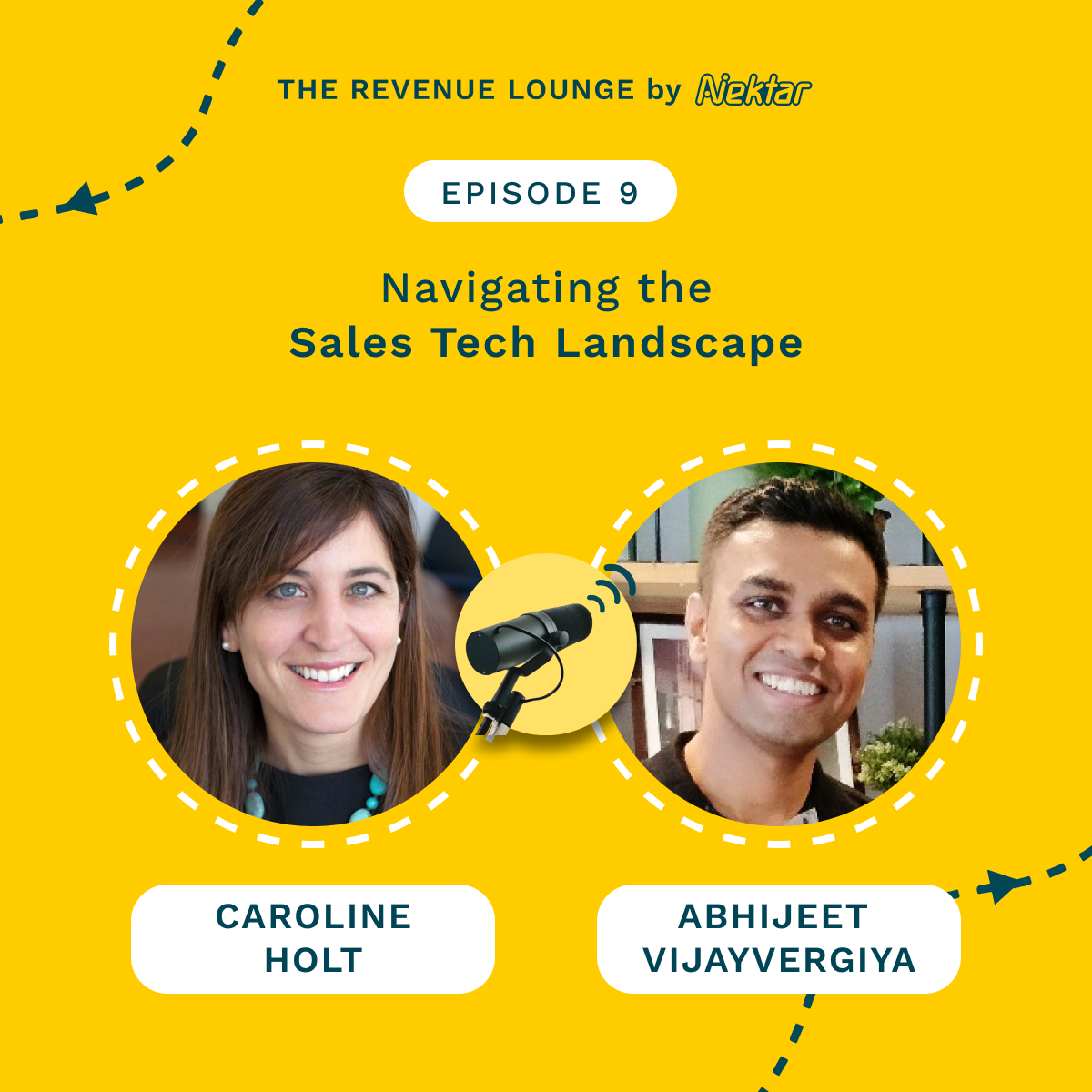
Ep #9: Navigating the Sales Tech Landscape
Listen Now